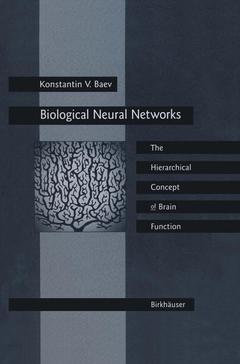Biological Neural Networks: Hierarchical Concept of Brain Function, 1998
Langue : Anglais
Auteur : Baev Konstantin V.

This book is devoted to a novel conceptual theoretical framework of neuro science and is an attempt to show that we can postulate a very small number of assumptions and utilize their heuristics to explain a very large spectrum of brain phenomena. The major assumption made in this book is that inborn and acquired neural automatisms are generated according to the same func tional principles. Accordingly, the principles that have been revealed experi mentally to govern inborn motor automatisms, such as locomotion and scratching, are used to elucidate the nature of acquired or learned automat isms. This approach allowed me to apply the language of control theory to describe functions of biological neural networks. You, the reader, can judge the logic of the conclusions regarding brain phenomena that the book derives from these assumptions. If you find the argument flawless, one can call it common sense and consider that to be the best praise for a chain of logical conclusions. For the sake of clarity, I have attempted to make this monograph as readable as possible. Special attention has been given to describing some of the concepts of optimal control theory in such a way that it will be under standable to a biologist or physician. I have also included plenty of illustra tive examples and references designed to demonstrate the appropriateness and applicability of these conceptual theoretical notions for the neurosciences.
1 Limitations of Analytical Mechanistic Approaches to Biological Neural Networks.- 1.1 Inborn Automatic Behaviors From the Point of View of Classical Theory.- 1.1.1 A Brief Review of the Locomotor Behavior Evolution in Animals.- 1.1.2 Initiation of Inborn Automatic Behaviors.- 1.1.3 The Problem of Organization of Central Pattern Generators for Inborn Automatic Behaviors.- 1.1.4 Afferent Correction of Central Pattern Generators.- 1.1.5 Ontogenesis of Locomotor Function.- 1.1.6 Is the Formulation of the Generator Problem Correct?.- 1.2 Learning from the Point of View of Classical Theory.- 1.2.1 Classical Conditioning of the Eyelid Closure Response.- 2 The Control Theory Approach to Biological Neural Networks.- 2.1 A Brief Historical Review of the Development of Automatic Control Theory.- 2.2 Basic Concepts of Control Theory.- 2.3 Computational Abilities of Biological Neural Networks.- 2.4 Broadening the Concept of Automatism: Inborn Automatisms and Acquired Habits.- 2.5 How Can Control Theory Concepts Be Applied to Biological Neural Networks?.- 3 A Central Pattern Generator Includes A Model of Controlled Object: An Experimental Proof.- 4 The Spinal Motor Optimal Control System.- 4.1 Sensory Information Processing in the Spinal Motor Control System.- 4.2 The Essence of the Internal Model of the Controlled Object.- 4.3 The Internal Representation of the Controlled Object Phase State.- 4.4 The Principal Features of the Neural Organization of Internal Representations of the Controlled Object State and Its Model.- 4.5 Neural Mechanisms for Calculating the Most Probable Current State of the Controlled Object.- 5 Generalizing the Concept of a Neural Optimal Control System: A Generic Neural Optimal Control System.- 6 Learning in Artificial and Biological Neural Networks.- 6.1 The Problem of Learning in Neurocomputing.- 6.2 Basic Principles of Learning in Biological Neural Networks.- 6.2.1 An Analogy: Brownian Motion of Particles in the Presence of a Temperature Gradient.- 6.2.2 Change of Neuronal Transfer Function Due to the Influence of Initiating Signals.- 6.2.3 Change of a Function Calculated by a Neural Network.- 6.2.4 Basic Principles of Classical Conditioning.- 7 The Hierarchy of Neural Control Systems.- 8 Application of the Concept of Optimal Control Systems to Inborn Motor Automatisms in Various Animal Species.- 8.1 The Principle of Motor Automatism Initiation.- 8.2 Invertebrate Central Pattern Generators from the Perspective of the Optimal Control System.- 8.3 Vertebrate Central Pattern Generators from the Perspective of the Optimal Control System.- 8.4 The Phenomenon of Entrainment of Central Rhythms.- 8.5 A Generator is a Learning System!.- 9 The Stretch-Reflex System.- 10 The Cerebellum.- 10.1 The Semantics of Cerebellar Inputs.- 10.2 How the Cerebellum Learns to Coordinate Movements.- 11 The Skeletomotor Cortico-Basal Ganglia-Thalamocortical Circuit.- 11.1 An Anatomical Survey of Cortico-Basal Ganglia-Thalamocortical Circuits.- 11.2 What is Modeled by the Skeletomotor Basal Ganglia-Thalamocortical Circuit?.- 11.3 An Error Distribution System.- 11.4 Clinical Applications of the Theory.- 11.4.1 Parkinson’s Disease.- 12 The Limbic System.- 12.1 Associated Automatisms.- 12.1.1 Automatisms Subordinated to the Hypothalamus.- 12.1.2 Initiating Signals of the Hypothalamus.- 12.1.3 Cortical Automatisms Used by the Limbic System.- 12.2 Specificity of Control Tasks: General Considerations.- 12.2.1 The Coordination Problem.- 12.2.2 Long-Range Space and Time Orientation.- 12.2.3 From Conditioned Reflex to Operant Learning.- 12.3 Functions of Different Limbic Structures.- 12.3.1 The Hypothalamus.- 12.3.2 The Hippocampus.- 12.3.3 The Cingulate Gyrus and its Cortico-Basal Ganglia-Thalamocortical Loop.- 13 The Prefrontal Cortex.- 13.1 Means for Further Evolutionary Improvements.- 13.2 Prefrontal Cortico-Basal Ganglia-Thalamocortical Loops.- 14 Conclusion.- 14.1 The Variety of Memory Mechanisms in the Brain.- 14.2 Non-Neuronal Network Cellular and Molecular Systems.- 14.2.1 The Immune System.- 14.2.2 Intracellular Systems.- 14.3 Evolution and Learning Processes.- 14.4 Self-Applicability of the Theory and Its Application to Other Sciences.- 14.5 Future of Neurobiology for Physicists.- 14.6 Artificial Intelligence and Future Neurocomputers.- References.- 1 The Main Properties of Sensory Information Sources and Channels.- 2 Functioning of the Internal Model of the Controlled Object.- 3 The Spinal Optimal Motor Control System as a Neural Network.- Abbreviations.
Date de parution : 09-2011
Ouvrage de 273 p.
15.5x23.5 cm
Disponible chez l'éditeur (délai d'approvisionnement : 15 jours).
Prix indicatif 158,24 €
Ajouter au panierThème de Biological Neural Networks: Hierarchical Concept of... :
Mots-clés :
Biological Networks; Cortex; Signal; Structure and Organization; artificial intelligence; behavior; model; semantics
© 2024 LAVOISIER S.A.S.



